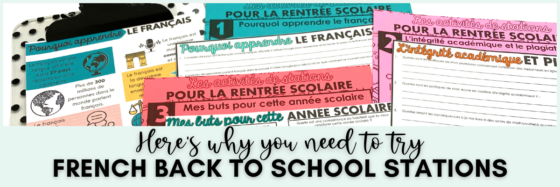
How do I get my French students to speak French in French class? Whether you are a Core French teacher or French Immersion teacher, this is probably something you struggle with or have struggled with in the past. In this blog post, I am sharing some strategies that have worked really well in my classroom so that you can get your students to finally speak more French in class.
The environment matters : students must feel comfortable and safe if you want them to speak French in class
Before we get to routines and assessment, we need to discuss the classroom culture. When I meet my absolute beginners (Grade 8s), I spend 1-2 weeks setting up the environment. Kindness and empathy are two factors that I stress. In this time when students are exploring boundaries (and trying to see what they can get away with), I also enforce my policies very strictly.
For example, when they giggle when they hear another student speak French, that needs to be nipped in the bud right away!
Additionally, how do YOU make your students feel? Can your students trust you?
Learning a language and feeling comfortable speaking in a new language is REALLY scary. World language classes are probably one of the scariest when it comes to students having to take risks on a regular basis.
Therefore, we must acknowledge the fear and uncertainty our students may feel.
In my first year of university, I had a professor who had a clipboard with all of our names on it. Each time we spoke, she would tick off our name. I guess she was trying to encourage us all to participate in class?
However, what really happened was that I became extremely anxious to the point where I had a panic attack before class.
You have to consider the impacts (inadvertent or intentional) of your policies and procedures on your students and that they may actually be having the opposite effect.
Practices/strategies I do not employ in my classroom to get my students to speak French
- Collect participation marks – we are actually not allowed to collect these in my province
- Take note of who speaks when
- Pick on my (anxious, nervous) students
- do oral quizzes or tests
Consequently, doing any or all of the things above will not actually guarantee that your students will a) be comfortable taking risks or b) speak French in French class.
What are your priorities?
What I have learned in the past few years is that I cannot prioritize reading, writing, listening, and speaking French equally. Not yet anyway!
When I was prioritizing writing French, my students’ French oral communication skills were lacking.
Now that I am prioritizing listening and speaking French, I am noticing that my students’ writing is not perfect.
However, that is totally okay!
Prioritizing speaking French has meant that I have actually exposed my students’ to using a number of sentence structures really well.
I prioritized my Grade 9 students asking and responding to questions in French for an entire semester via Question du jour and other strategies. While doing this, they implicitly picked up SO much vocabulary and sentence structures without a single worksheet.
However, there is still A LOT that they do not know. I am okay with that!
It just means that I am not assessing their work from a deficit perspective. Instead, I am marking what they DO know and what they CAN do really well.
So when I look at their journals, instead of seeing ALL of the mistakes, I view the following as successes :
- my students no longer struggle with “I don’t how to start because I don’t know French”. Their comfort in speaking has resulted in their comfort in knowing that they can express themselves in French in a number of different ways, writing being one of them
- I don’t focus on the mistakes. Instead I am excited about how much vocabulary they are able to employ without my help
Rome was not built in a day. Build routines. Be consistent.
My most successful strategy is being very strategic with choosing your French routines. Every single class, we practiced the same skills over and over again.
It felt like we went from “um my students know nothing?” to “OMG HOW DO THEY KNOW THAT??”.
I have a whole blog post dedicated to French classroom routines so do be sure to go read it for ideas and inspiration.
Okay – but, why routines in a French classroom? How do routines help students speak French and feel comfortable communicating in French?
Because Core French students need that consistent repetition! Learning a concept and practicing it a few times is not enough in a French-language classroom.
Instead, if you build routines that target very specific skills and repeat these routines, your French students get tons of repetition.
For example, by doing French question du jour every single day for a month, my students’ pronunciation improved drastically. Their understanding of sentence structures also increased. Additionally, their understanding of French interrogatives was AMAZING. All this with one simple French classroom routine!
Do you speak French in class?
I know this may sound silly, but are you speaking enough French in class? Most of your class and lesson should be conducted in the target language.
“But then how will my students understand what I am teaching then?”
The problem with the question above is that I assume you are teaching grammar and vocabulary. Therefore you “need” to teach in French in order for your students to understand.
I actually don’t teach much French grammar explicitly. Instead, my classroom is a lot like a French Immersion classroom in that I am teaching concepts in French. For example, the other day I introduced my French 9 students to la francophonie by doing a map talk all in French.
Speaking in French to your students is so important because your students will pick up so much without you actually teaching them explicitly. In my opinion, this kind of learning is truly magical and meaningful!
Greet them at the door with “bonjour” and “comment ça va?”
If you teach French 8 or French 1 (beginners), do you greet your students at the door with a “bonjour” and “comment ça va?”.
If you do not, I highly recommend it! I know it takes away from doing some prep or responding to emails. As a full-time teacher with no prep time I get the importance of that.
Greeting your students at the door means that your students :
- are immersed in the language as soon as they walk through the door
- get to practice asking / responding to the same questions every day
Break the ice by beginning every class with Question du jour
One of my students’ favourite French classroom routines is Question du jour. As I take attendance, a beginner-friendly prompt is displayed on the board and students answer it one at a time.
This strategy was so successful with my students!
It became “our thing” and the few times it wasn’t on our daily slide, students told me we couldn’t skip question du jour!
Here’s what happened after we did question du jour every single class for a whole semester :
- I didn’t have to teach French interrogative words “qui, quoi, est-ce que, quel, etc”. They learned these by seeing them every single class
- They implicitly picked up a lot of sentence structures
- Listening to their peers say the same answer was really helpful in improving their pronunciation without explicitly teaching them sounds
- By the end of the semester, my French 9 students were extremely comfortable asking and responding to questions in French
- They remembered so much of the vocabulary they had only seen a few times (win!)
These French-speaking prompts were so successful I made a bunch of different ones for different French levels!




Try out “speed-dating” once a week
The purpose of this French-speaking activity is to get your students to communicate with one another in French!
This is an awesome activity for the following reasons :
- Students practice asking and responding to at least 10-15 questions
- Students speak in French to numerous different peers so it’s a great get to know you activity
With my second-year French students (French 9), we do speed dating once a week! Here’s how to structure this activity with your class :
- after question du jour, ask students to take out their “speed dating” page
- Get your students to write down one question they want to ask their peers (I give them a couple of minutes to do this)
- Number everyone off as A or B
- Take everyone out into an open space on my floor. If you don’t have this, you can also take your students outside
- Have them form two lines (A and B). They face a partner and ask/respond to one another’s questions. I remind them to begin their conversations with “bonjour, comment ça va?”.
- After about a minute, I ring my bell and the person at the front of line A goes to the back and everyone scoots over one person and begins to chat with their new partner
Sometimes we don’t necessarily have time to do this activity so I change it up sometimes :
- ask Mme 30 questions (I do this 1-2 times every semester) or even ask a student 30 questions
- 15 classmates come up to the front of the classroom and the other 15 peers ask them a question (I switch to this format halfway into the semester when they have built significance confidence and comfort).
Repetition is key to getting your French students to speak French in class and this activity definitely ensures that repetition!
Repeat simple structures regularly
If you are teaching beginner French students or intermediate French students, pick phrases to repeat every single class. For example :
- qu’est-ce que ça veut dire, les élèves?
- D’accord?
- levez la main
- Est-ce que vous comprenez?
- Est-ce que je peux effacer?
- comment dit-on…
- discutez en partenaires
Sometimes we get comfortable and we give instructions to our students in English for a variety of reasons. I actually encourage you to give specific instructions in French and to repeat them over and over. Your students will actually pick up on them so quickly!
Have visual cues on your walls and boards
Lastly, utilize French posters or French classroom decor as visual cues for your students. Here are examples of posters that I like having up in my own classroom :
- French interrogative words
- French pronunciation posters
- French subject pronouns







